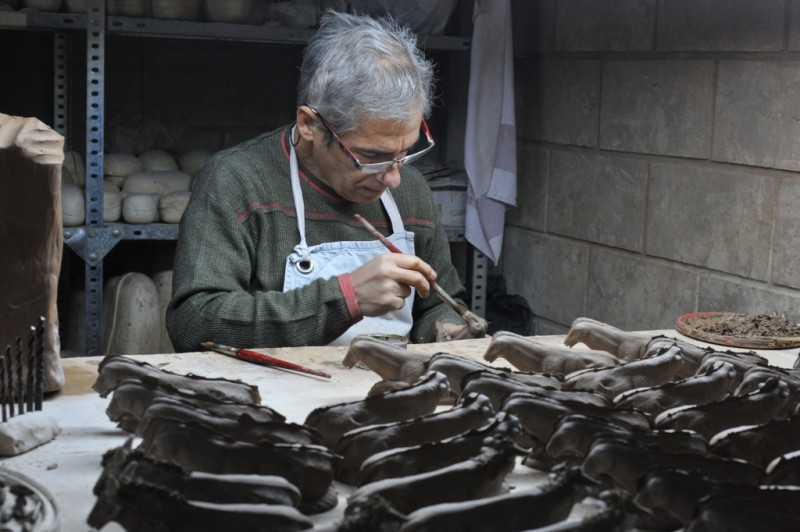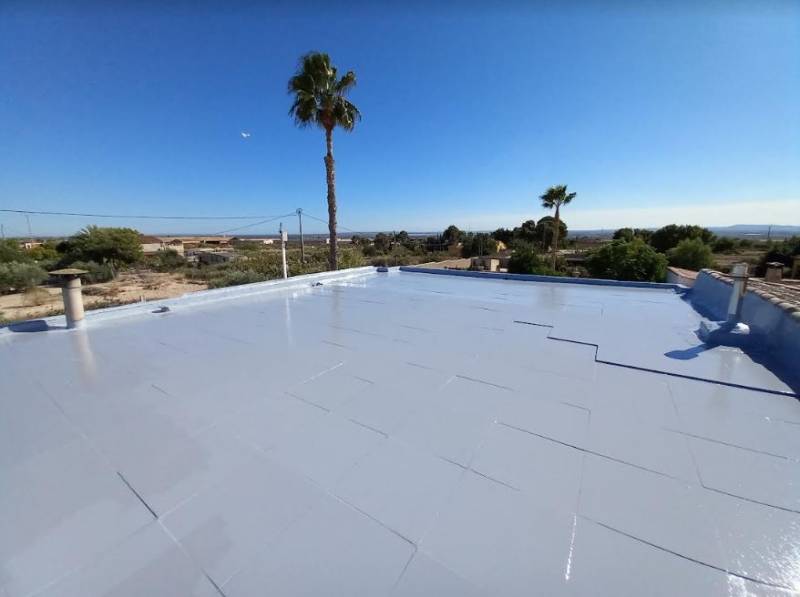
To be listed on the CAMPOSOL TODAY MAP please call +34 968 018 268.

Guidelines for submitting articles to Condado Today
Hello, and thank you for choosing CondadoToday.com to publicise your organisation’s info or event.
Condado Today is a website set up by Murcia Today specifically for residents of the urbanisation in Southwest Murcia, providing news and information on what’s happening in the local area, which is the largest English-speaking expat area in the Region of Murcia.
When submitting text to be included on Condado Today, please abide by the following guidelines so we can upload your article as swiftly as possible:
Send an email to editor@condadotoday.com or contact@murciatoday.com
Attach the information in a Word Document or Google Doc
Include all relevant points, including:
Who is the organisation running the event?
Where is it happening?
When?
How much does it cost?
Is it necessary to book beforehand, or can people just show up on the day?
…but try not to exceed 300 words
Also attach a photo to illustrate your article, no more than 100kb

Murcian Master Belenistas continue the tradition of centuries
Manuel Nicolás Almansa, Juan Antonio Griñán Nicolas and Jesús Griñán Nicolás
The Region of Murcia has been a focal point for artisan traditions for nearly four thousand years and was not only an important trading centre on the trade routes of the Phoenicians as far back as 700 BC, but was also a production area for ceramics during the Bronze Age Argaric period, when the settlement known as La Bastida in Totana was inhabited by the Argaric Culture, and deposits of clay were extracted for the manufacture of ceramic pieces.
4,000 years later, Totana clay is still used in the production of the hand-made Belén nativity scenes which are such an essential element of any Murcian Christmas, the Master Belenistas of the Murcia Region amongst the most important in Spain and exporting their hand-crafted figures right around the world.
A Belén nativity scene is a core component of the seasonal celebrations in Spain and recounts the story of the nativity in a highly visual format, a vital means of transmitting the message of Christianity before literacy was widespread amongst the population.
The base of every nativity is the scene of Jesus lying in a manger, watched over by Joseph and Mary, a host of angels, the shepherds and their flocks and with the Three Kings in attendance.

From this point the nativity scene expands outwards, and the imagination of the Belenista is seemingly the only limit, as the stories of the nativity are re-told in an endless landscape of loving detail, the birth of Christ surrounded by scenes of daily life and the drama of his birth, flight and the slaughter of the innocents.
The base of the figures which recount these stories are first sculpted in clay, from which plaster moulds are then made, the figures cast from the earth, the barro, or clay forming the core figure, which is then painted or dressed with treated fabric, a laborious and time-intensive process, with every minute detail undertaken by hand.
Some of the figures are constructed using several moulds, a raised arm, or an outstretched hand each requiring separate moulds and even the tiny chickens which scratch in the dirt of every rural Belén must be fabricated and painted by hand, while details such as the mane of a donkey are laboriously added by hand to the base body of the mule.
Every Belenista brings their own character and style, each portraying the same subject through different eyes, and each bringing their own personality as they stride like proverbial Gullivers through the miniature worlds they create.
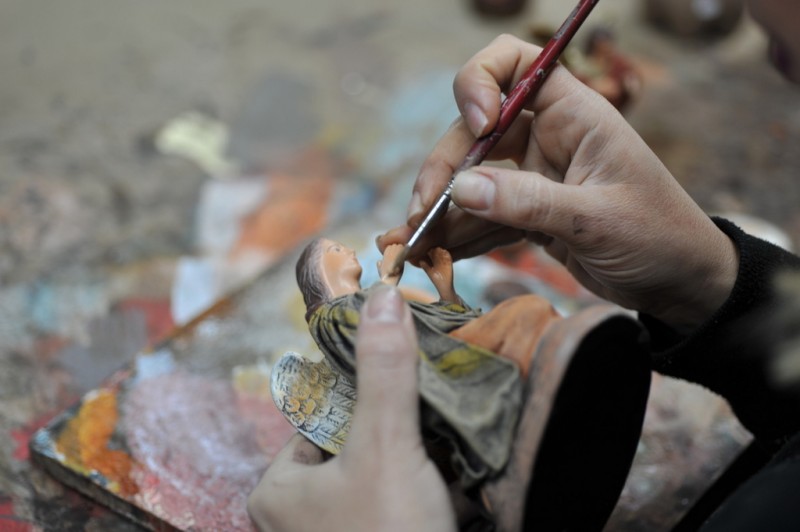
Their figures are set in complex landscapes, which grow and evolve at the hands of their owners, and no two are the same. Domestic nativities grace many private homes, with families extending their collection by purchasing new pieces every year, and huge belén scenes are the subject of bright eyed enthusiasm in municipal buildings, churches and town centres, covering many square meters, with windmills turning, fishermen fishing and monumental scenes, which often include local landmarks.
Murcian Belenes are full of character, reflecting the rural traditions and customs of the region, and during the festive season there are dozens which can be visited and enjoyed, each with its own personality and enchantment. (see feed below for details).
There are several skilled Belenistas working in the Murcia Region, selling their products through the three regional artisan centres, specialist shops and artisan markets, and Belenes “made in Murcia” are to be found in every corner of the world, including the Vatican and even as far afield as the Spanish Embassy in Hong Kong as well as in the Royal household of Spain and all principal cities.
We visited three of them in their studios to watch the laborious process of breathing life into wet Totana clay:
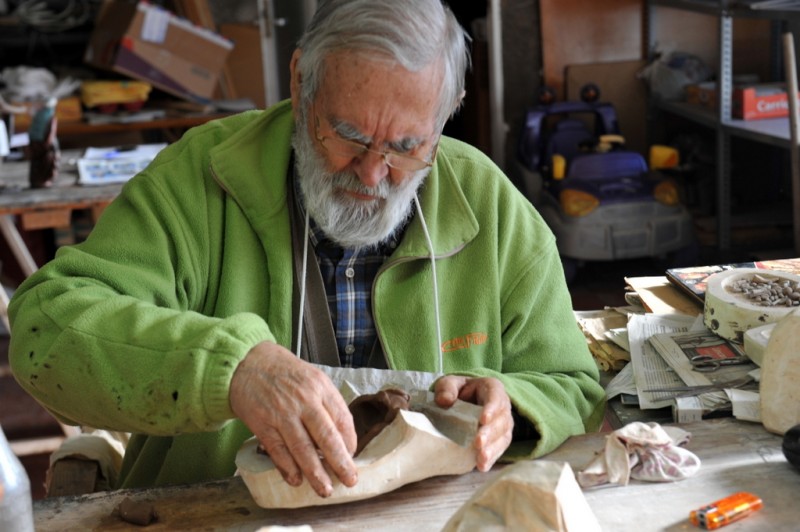
Manuel Nicolás Almansa
Born in 1932, Manuel Nicolás Almansa is a self-taught artist and sculptor, who has not only created some of the most important Belén nativity figures in the Murcia Region, but is also responsible for several of the best-known sculptural pieces in public areas (the Monumento al Pescador in Los Alcázares, or the Monumento al Huertano in the Jardín de la Seda in Murcia, amongst them.)
He created his first sculpted figures aged just 6, showing the natural creative talent which ran through his family, and by 18 had set up a workshop with his brother José, who made a commissioned copy of the Belén made by Baroque sculptor Francisco Salzillo which is the star exhibit of the Museo Salzillo in Murcia.
This hugely important Belén was made at the end of Salzillo’s lifetime, and was completed by his pupil Roque López, and although the flamboyant baroque pieces of the Salzillo Belén provided a point of inspiration which is undeniable for every Murcian Belenisat, the true source of material on which most of the figures of Manuel Nicolás Almansa are based, is the people who surrounded him as he grew up in the area alongside the El Cenajo reservoir.
Women washing clothes, the blind shepherd, the bee-keeper cutting a slice of dripping honeycomb, a threadbare old man carrying wood, the chestnut seller turning her earthy treasures over a glowing coal….these are the people who were familiar to a child who started to model them from mud and carried their faces in his head until he could immortalize them in clay.
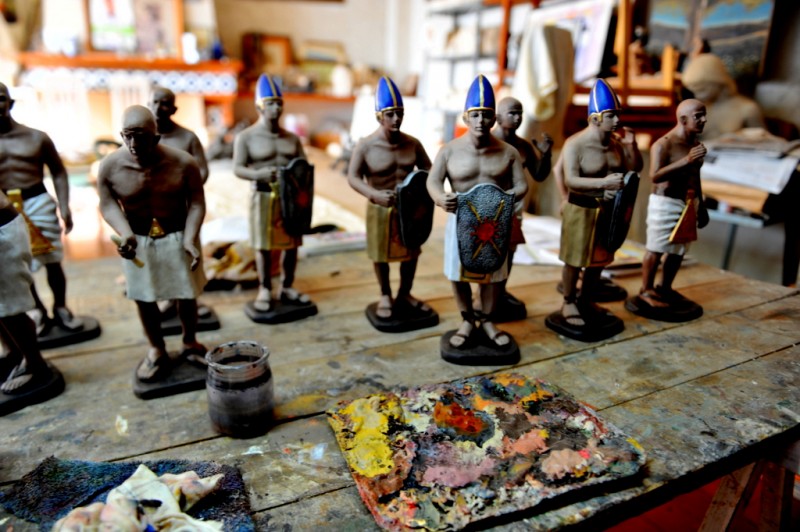
His work is detailed, perfectly balanced, every fold on a King’s cloak as important as the texture of a woolen shepherd’s jacket or tuft of hair on a mule’s back, because for him, a Belén is more than a work of art, it’s the embodiment of the comfortable echoes of his childhood, and he views his craft as a social labour, creating memories and the warm inner glow which embodies the essence of the perfect childhood Christmas.
He has watched generations of Murcian families collecting his work and for him there are no greater pleasures than the continuity of traditions as parents who first came to his workshop as excited children bring their own children and grandchildren to purchase a figure for their family Belén, the essence of joy, family and continuity expressed through the excitement of a child choosing the latest addition to the family nativity scene.
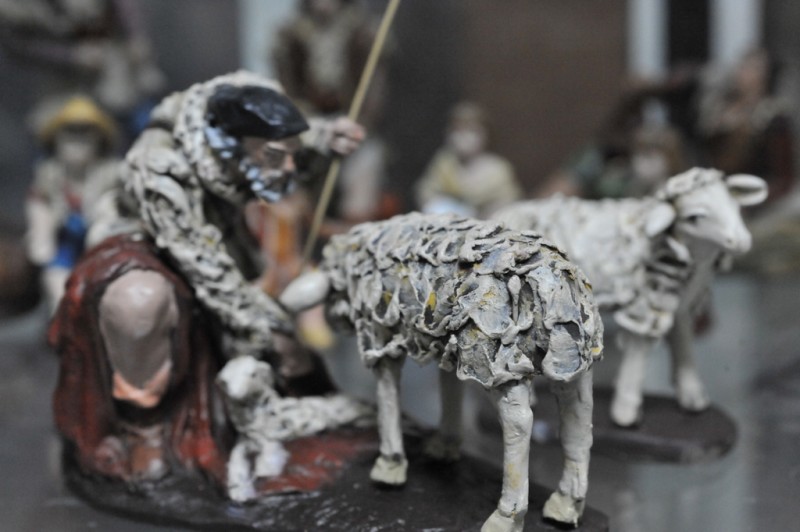
“I think about the faces of the children when I model, of the joy in their faces when they see my work,” he said, “for me, the belén is a tool through which children learn and I am very proud that I have been able to do what I love doing; making children happy.”
Although his work can be seen in the Museum of the Vatican, in the Museum of Decorative Arts in Madrid, the Pueblo Español of Barcelona, and countries as far flung as Honduras and Venezuela, as well as in the great belénes of the Murcia Region, such as the belén monumental in San Javier, the municipal Belén of Cartagena, and the Belén of the Cartagena Diocese in the Palacio Episcopal in Murcia, and he has been awarded a host of distinctions, it’s this sense of his great mission to conserve tradition and embody the spirit of the Murcian countryside in his work which most motivates him and his pieces stand alone for their dramatic Baroque detail and intrinsically Murcian character.
Contact details:
Manuel Nicolás Almansa S.L.
Calle Belenes nº 12
30012 Santiago el Mayor. Murcia
Telephone: 968 255 858 / 636 642 907
Email contact: rmnicolas@yahoo.es
Webpage: www.belenesonline.com
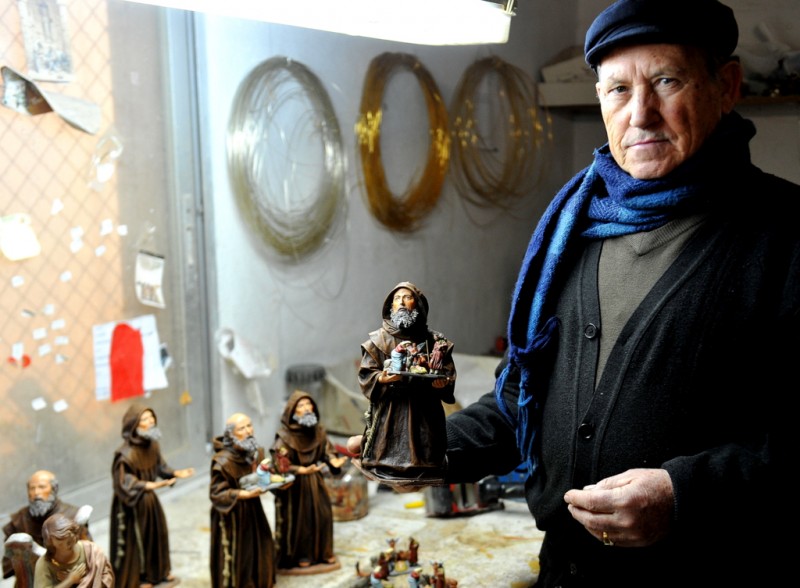
Maestros Artesanos, Juan Antonio Griñán Nicolas
Maestros Artesanos, founded by Juan Antonio Griñán Nicolas, now run by his son José Griñán.
Puente Tocinos lies in the heart of the rich orchards surrounding the urban centre of Murcia City and has become a focal point for the manufacture of Murcian Belenes, with the name Griñan at the centre of much of the artisan activity.
In its current format, Maestros Artesanos has been in production since 1994, although founder Juan Antonio Griñán Nicolas made his first figure in 1946, aged just 9.
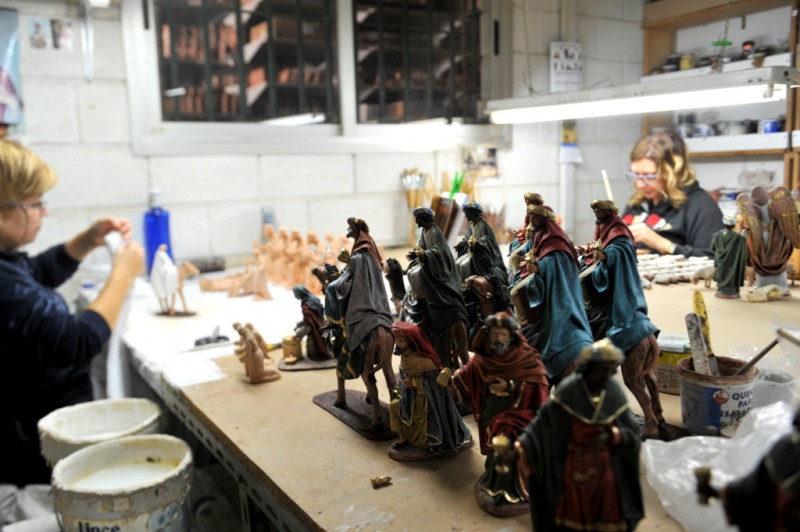
At this time the great belenes were still very much the province of the wealthy and the figures made for wider consumption were naïve and clumsy in their construction. Sheep were little more than a rounded blob on thin wire legs, and although these early belén figures have great charm, the style of figures which are now so popular, were not widely available.
At the time Juan Antonio made his first belén figure, these early pieces were sold from handcarts in the Murcian orchards, vendors pushing a cart from market to market to sell, or trade, their pieces, and it was not until the latter years of the twentieth century that the style of Belén Maestros Artesanos manufactures today became both popular, and accessible, for a wider audience.
The figures are all carefully made from hand using a clay base, with detail applied by hand, and a substantial number are dressed using an escayola fabric technique, so each one is slightly different, depending on how the soaked cloth is hung on the clay base figure, before being painted manually.
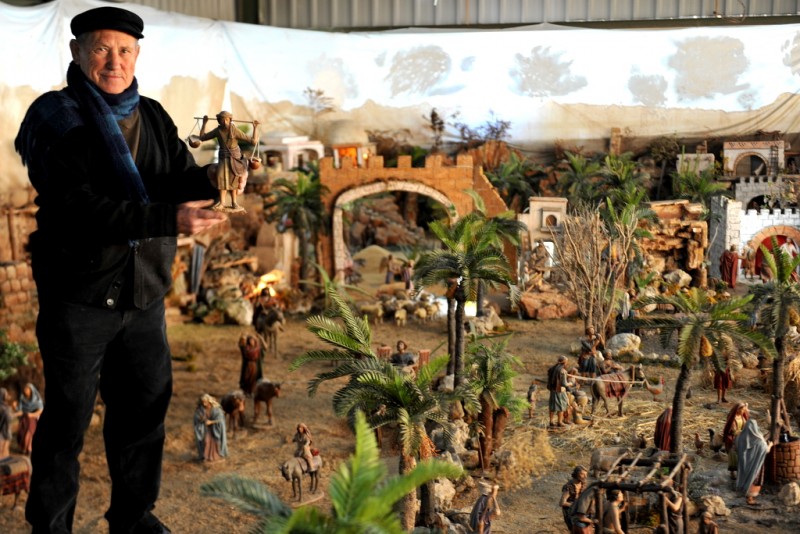
The company produces around 20,000 pieces a year and its principal markets are Madrid and Barcelona, although France, Italy and South America also purchase significant quantities of products.
Products are also sold at larger Christmas markets in Almería, Alicante, Elche and Murcia.
Highly aware of the need to compete with inferior products made in the Far East, the company maintains a competitive pricing strategy and focuses on the development of products which decrease its dependence on the seasonal nature of Belén manufacturing, also producing religious scenes for Semana Santa (Easter) and for shops selling religious materials, applying the same techniques used in the manufacture of its Belén figures, to produce items such as Saint Francis of Assisi, the man widely credited with creating the first nativity scene in 1223, when in an attempt to divert attention away from the materialistic acts of giving gifts and re-focus attention on the religious significance of Christmas, (800 years later many people still try to do the same thing!) he staged the first living nativity scene in Greccio, in central Italy. Pope Honorius III gave his public approval of the “living belén” and within 100 years no self-respecting Italian church would be seen without a nativity scene!
Far from relaxing during retirement Juan Antonio has spent three years creating his own private masterpiece in the attic of the workshops, a heartfelt tribute to his lifetime of work and homage to the tradition of belén artwork in the Murcia Region.
Contact details:
Maestros Artesanos S.L.
C/ Amistad nº 10
30006 Puente Tocinos. Murcia
Tfno: 968 301 481 / 649 888 329
Web: www.maestrosartesanos.com / www.lafabricadelbelen.com
Email: info@maestrosartesanos.com
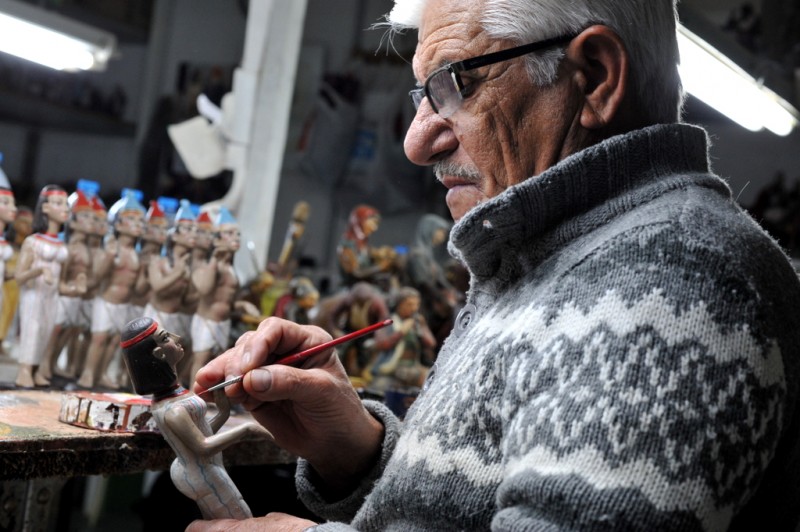
Jesús Griñán Nicolás
Jesús Griñán Nicolás is one of the most important Master Belenistas working in Spain and was born in Puente Tocinos in 1944, a focal point for belén manufacture within the Murcia Region, beginning his career aged just eight when he started an apprenticeship as a trainee belenista.
He has since gained worldwide renown due to the quality and artistry of the pieces he models, and his clients number royals and rock stars, one of his most prestigious clients being Pope John Paul II, who selected a Jesús Griñán Belén for his own private office until his death in 2005.
Keen to hone his skills, Griñán studied art at the Escuela de Artes y Oficios de Murcia, before dedicating his life to the art of making nativity belén pieces, working in the prestigious workshops of Galán, Ortigas Méndez and Cuenca, and finally opening his own premises in 1983.
Although well past retirement age he continues to work in the business, which is now run by his family, innovating and sculpting new pieces for the portfolio of the company and in 2017 was awarded the prestigious prize for artisan of the year by the regional artisan ministry.
During the two year period between 2015 and 2017 he has also been engaged in a large-scale project to restore the five hundred pieces which are displayed every year in the Belén monumental of San Javier, the largest in the region and amongst the largest in Europe, which celebrates its 50th anniversary in 2017.
A number of the figures are themselves as old as the belén, so Griñán has repainted and repaired not only his own creations, but also some of the originals made by Pedro Serrano fifty years ago. Alongside the new-look figures, the Belén monumental will also include a number of new scenes and structures for Christmas 2017.
The belén of the parroquial church of San Javier in the municipality was also made by his workshop and this year the museum hosts a special exhibition dedicated to a lifetime of his work, many of the pieces coming from his own private collection.
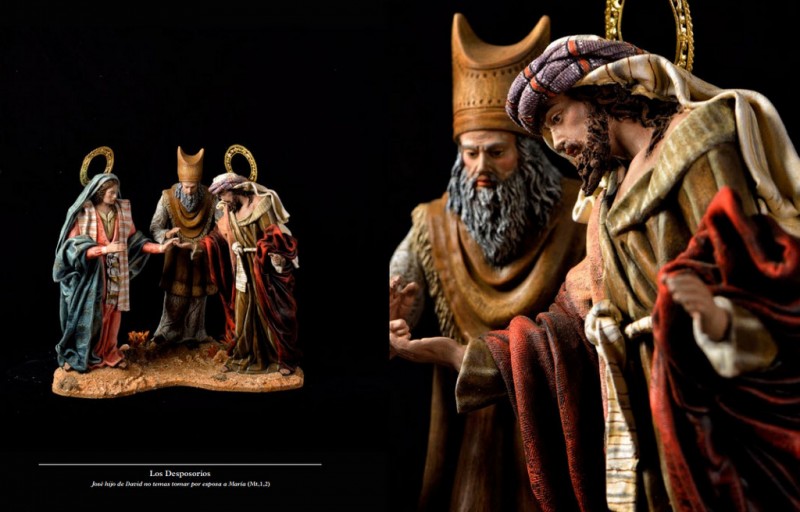
Those looking to see his work will find many examples in the best belenes of the region, from Lorca and Fortuna through to Molina de Segura and Murcia, and those with a real taste for adventure can even see a nativity submerged in the Cueva El Lago in Cabo Tiñoso in Mazarrón!
His work has also become an ambassador for Murcian Beléns through a wide network of prestigious commissions, the Louvre Museum in Paris, the Museo de la Ciudad in Madrid, the Museo of las Palmas in Gran Canaria, with nativities in Japan, Brussels, Brazil, across Scandinavia and the USA, amongst many others.
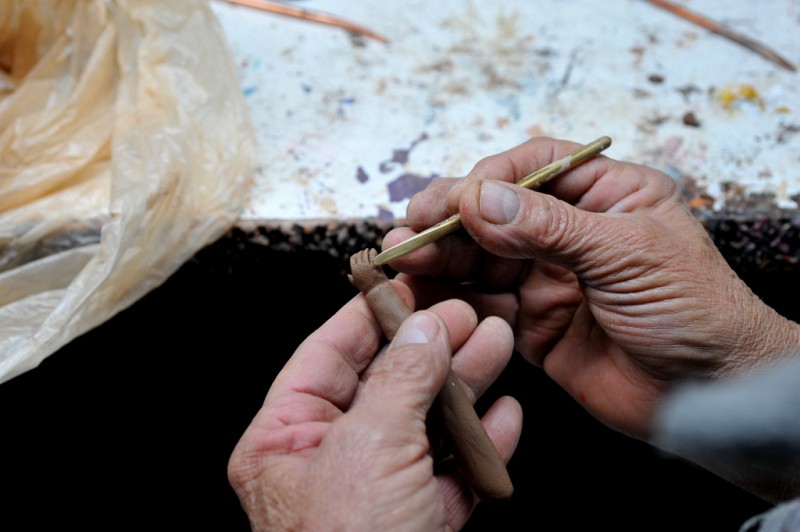
Characterised by exquisite detail, his work is influenced by the ebullience of the baroque but firmly rooted in the reality of accurate and empathetic characterization, capturing the flow of fabric and the intensity of expression in the positioning of every part of the body.
The company today sells every element the Belén enthusiast could possibly desire, marketing not only the figures themselves, but also the waterwheels, threshing donkeys, dovecotes, bread makers and waterfalls which can help belén lovers to build their own monumental belén at home piece by piece, right down to the tiny baskets of fruit sold at the market scenes near to the inn and the miniature mice nibbling away at the corn as the agriculturalists till their soil.
The products created by Belenes Murcia can be purchased through specialist religious outlets, at artisan fairs, online and directly from the business unit in Puente Tocinos where visitors will often find Jesús Griñán in the workshops working on his latest creation, along with his family.
Contact details:
Belenes Murcia, Jesús Griñan S. L.
Carril de la Manresa. Nave 23
30006 Puente Tocinos. Murcia
Telephone: 968 301 640
Webpage: www.belenesmurcia.com








